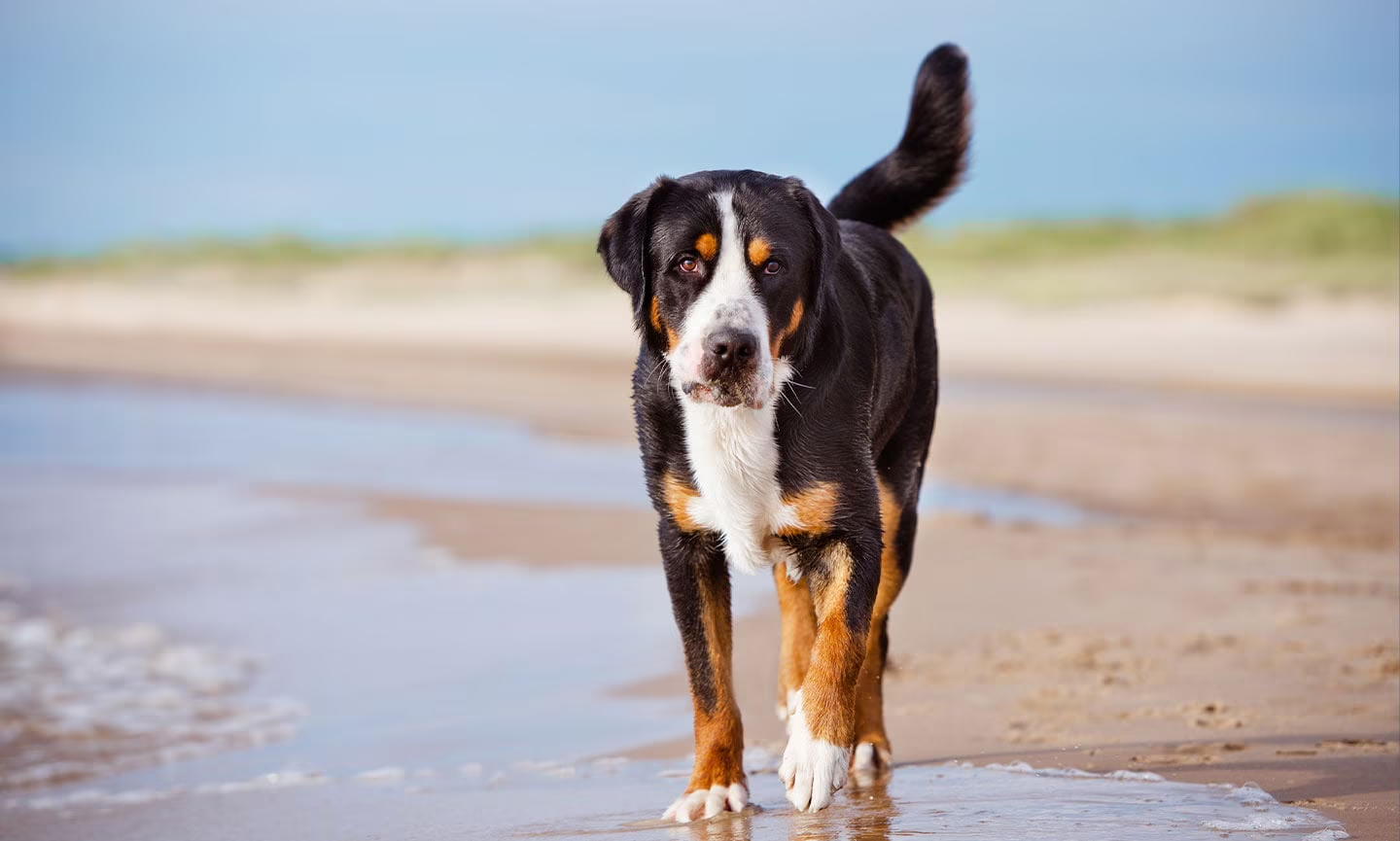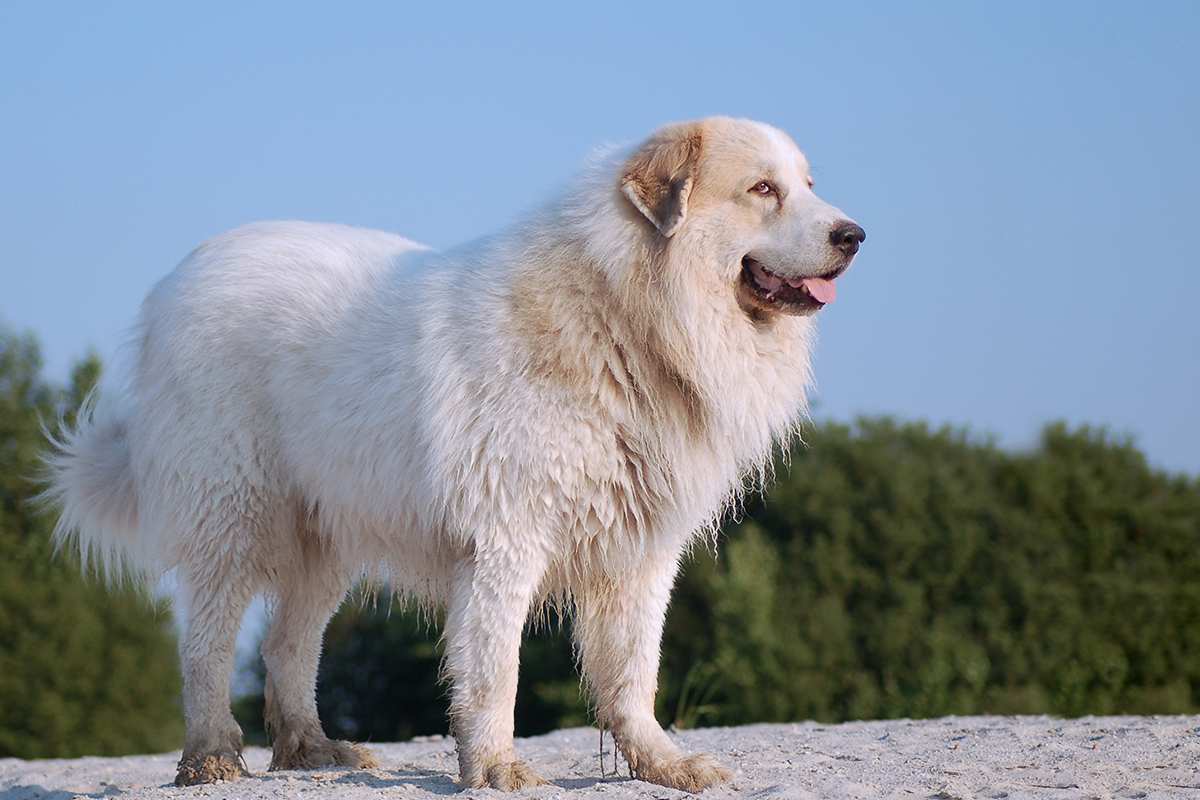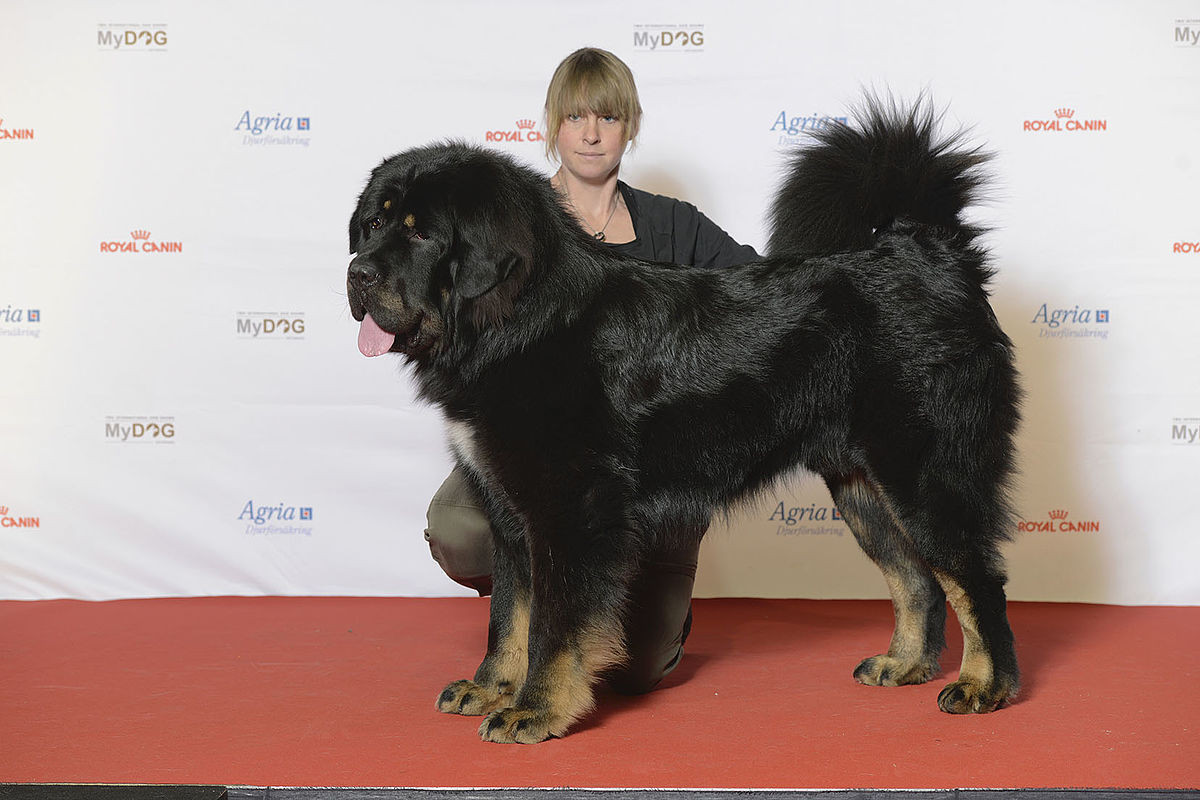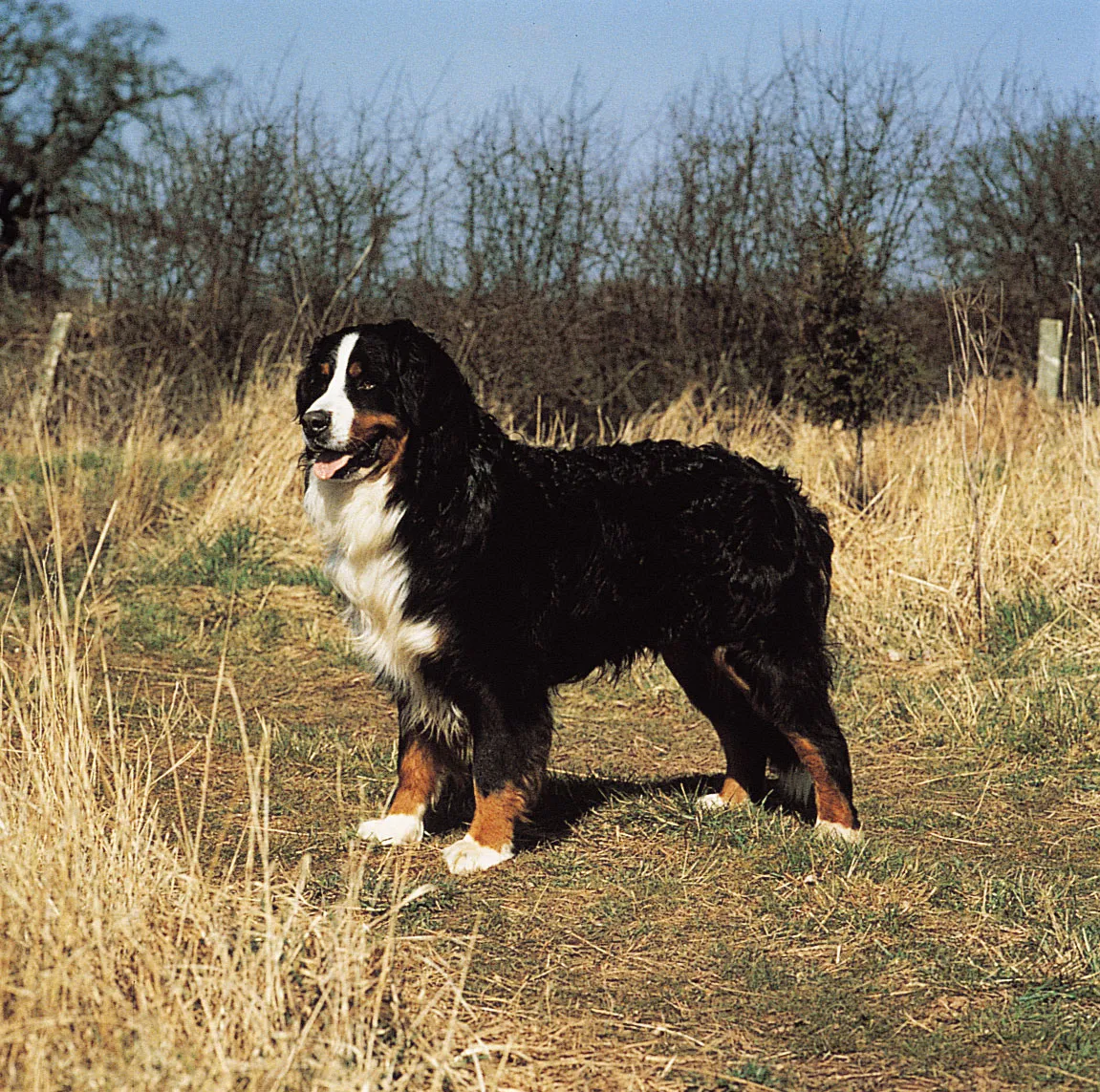If you’ve ever spotted a massive tricolor dog with the build of a tank and the temperament of a teddy bear, chances are you’ve encountered a Greater Swiss Mountain Dog. Often lovingly called “Swissies” by enthusiasts, these gentle giants are the definition of a diamond in the rough – powerful and sturdy on the outside, but absolute sweethearts on the inside.
As someone who’s spent countless hours researching dog breeds (and might occasionally be caught scrolling through dog photos at 2 AM), I can confidently say that the Greater Swiss Mountain Dog stands out in the crowded world of canine companions. They’re relatively rare in the United States, which means many people aren’t familiar with these magnificent creatures and what makes them so special.
Today, I’m diving deep into everything you need to know about the Greater Swiss Mountain Dog – from their fascinating history as Swiss farm dogs to their needs as family pets. Whether you’re considering adding one to your family or just love learning about unique dog breeds, this guide will give you the full Swissy scoop!
The Ancient Heritage of the Swiss Giant
The Greater Swiss Mountain Dog boasts one of the oldest and most interesting histories among domesticated dogs. These magnificent animals are believed to be descendants of large mastiff-type dogs brought to Switzerland by Roman legions during Julius Caesar’s campaigns over 2,000 years ago. These Roman war dogs bred with local dogs, eventually developing into the mountain dogs we know today.
For centuries, these powerful dogs served as invaluable working companions in the Swiss Alps. Their primary roles included:
- Drafting dogs: Pulling carts loaded with milk, cheese, and other goods to market
- Herding dogs: Managing cattle and other livestock
- Guardian dogs: Protecting farms and homesteads
- All-purpose farm dogs: Helping with various tasks around Swiss farms
Interestingly, the Greater Swiss Mountain Dog is the largest and oldest of the four Swiss Sennenhund breeds, which also include the Bernese Mountain Dog, Appenzeller Sennenhund, and Entlebucher Mountain Dog. All share similar tricolor markings but differ in size and coat type.
Despite their ancient heritage, the breed nearly disappeared in the early 20th century as modernization reduced the need for working farm dogs. The breed’s revival began in 1908 when Swiss canine researcher Professor Albert Heim recognized a short-haired Sennenhund at a dog show and encouraged the preservation of what would become known as the Greater Swiss Mountain Dog.
The breed didn’t make its way to the United States until 1968, and was officially recognized by the American Kennel Club in 1995. Today, while still relatively uncommon, these magnificent dogs are steadily gaining popularity as both working dogs and family companions.
Unmistakable Appearance: The Hallmarks of a Swissy
There’s no mistaking a Greater Swiss Mountain Dog – these imposing canines have a distinctive look that turns heads wherever they go. Let’s break down their striking appearance:
Size and Build
The Greater Swiss Mountain Dog is truly a giant breed, with males standing 25.5-28.5 inches at the shoulder and weighing between 105-140 pounds. Females are slightly smaller but still substantial at 23.5-27 inches tall and 85-110 pounds. Their bodies are robust and muscular with a broad chest and strong bone structure – a build that reflects their history as hard-working draft dogs.
Despite their imposing size, Swissies are remarkably agile and well-proportioned. They’re slightly longer than tall, giving them a balanced appearance rather than the extreme bulk seen in some mastiff breeds.
Distinctive Coat and Coloring
One of the most recognizable features of the Greater Swiss Mountain Dog is their striking tricolor coat. The base color is black with rich rust-red markings on the legs, cheeks, above the eyes, and often in two spots on the chest. A white “Swiss cross” marking on the chest and white markings on the muzzle, feet, and tail tip complete the classic look.
Unlike their long-haired cousin, the Bernese Mountain Dog, Swissies have a short, dense double coat. The outer coat is about 1-2 inches long, while the undercoat is thick and may vary seasonally. This shorter coat was practical for working dogs who needed less maintenance while still having protection from the Alpine elements.
Facial Features
Swissies have expressive, almond-shaped eyes that are usually dark brown and convey their gentle, alert temperament. Their ears are medium-sized, triangular, and fold forward close to the head when at rest. The overall head is broad with a flat skull and a slight stop (the transition from forehead to muzzle).
Perhaps most endearing is the expression that many Swissy owners describe as “intelligent and interested” – these dogs always seem to be watching and thinking, giving them a soulful, engaged appearance that many find irresistible.
Temperament: The Heart of a Gentle Giant
While the Greater Swiss Mountain Dog’s size might initially be intimidating, these dogs are renowned for their exceptionally balanced temperament. Here’s what you can expect from a well-bred Swissy:
Loyal and Devoted Family Companions
At their core, Swissies are family dogs who form deep bonds with their people. They’re famously loyal and often develop special attachments to each family member while remaining somewhat reserved with strangers. This doesn’t mean they’re unfriendly – they’re simply discerning about who earns their full affection.
Greater Swiss Mountain Dogs thrive on human interaction and don’t do well when left alone for extended periods. They want to be wherever the action is, whether that’s helping with chores around the yard or simply lounging in the living room while you watch TV.
Good with Children and Other Pets
Despite their size, Swissies are typically excellent with children, displaying patience and gentleness that seems at odds with their imposing stature. They’re often described as “nanny dogs” due to their protective yet gentle nature around kids.
That said, early socialization is crucial, and their size means all interactions with small children should be supervised – not because they’re aggressive, but because an excited Swissy could accidentally knock over a small child during play.
When properly socialized, Greater Swiss Mountain Dogs typically get along well with other dogs and even cats, especially if they’re raised together. Their herding instinct may occasionally manifest as a desire to chase smaller animals, but this can usually be managed with proper training.
Alert Watchdogs, Not Guard Dogs
Thanks to their heritage as farm dogs, Swissies are naturally alert and will bark to announce visitors or unusual activities. Their deep, powerful bark and impressive size make them excellent deterrents, though they’re not typically aggressive enough to be true guard dogs.
The breed standard describes an ideal temperament as “bold and faithful,” which perfectly captures their balanced approach – they’re confident without being aggressive, and protective without being paranoid.
Working Drive and Intelligence
Don’t let their sometimes laid-back demeanor fool you – these dogs have a strong working drive inherited from generations of farm work. Greater Swiss Mountain Dogs excel in activities that engage their minds and bodies, particularly pulling carts (drafting), weight pulling, hiking, and even some herding activities.
They’re intelligent dogs who learn quickly, though they can have an independent streak that manifests as selective hearing when something more interesting catches their attention. Training should focus on positive reinforcement while respecting their working dog heritage.
Health Considerations: Understanding Swissy Wellness
When bringing any dog into your life, understanding their health profile is essential for providing proper care. The Greater Swiss Mountain Dog is generally considered relatively healthy for a large breed, but they do have some specific health concerns to be aware of:
Lifespan
The average lifespan of a Greater Swiss Mountain Dog is 8-10 years, which is fairly typical for dogs of their size. Some Swissies may reach 11-12 years with excellent care, proper nutrition, and good genetics. While this lifespan is shorter than what you might expect from small or medium breeds, it’s actually quite good for a dog of this size – they typically outlive Bernese Mountain Dogs, for example, which generally live 6-8 years.
Common Health Concerns
As with many large breeds, Swissies are prone to certain health conditions:
- Gastric Dilatation-Volvulus (Bloat): This life-threatening condition occurs when the stomach fills with gas and then twists. It requires immediate emergency treatment and is one of the most serious health concerns for deep-chested breeds like the Swissy.
- Splenic Torsion: Similar to bloat but involving the spleen, this condition is more common in Swissies than in many other breeds. Signs include lethargy, pale gums, and abdominal pain.
- Hip and Elbow Dysplasia: These developmental conditions affect the joints and can lead to arthritis and mobility issues. Responsible breeders screen for these conditions.
- Epilepsy: Some lines may be prone to seizure disorders, which typically appear between 1-3 years of age.
- Eye Issues: Various eye conditions can affect the breed, including entropion (inward-turning eyelids) and distichiasis (abnormal eyelash growth).
While this list might seem concerning, it’s worth noting that not all Swissies will develop these conditions. Working with a reputable breeder who conducts appropriate health testing and maintains transparency about their lines can significantly reduce the risk of these issues.
Preventive Care
To help your Greater Swiss Mountain Dog live a long, healthy life:
- Schedule regular veterinary check-ups, ideally twice yearly for adult dogs
- Feed multiple small meals rather than one large meal to reduce the risk of bloat
- Consider a gastropexy surgery (stomach tacking) to prevent bloat
- Maintain a healthy weight to reduce stress on joints
- Provide appropriate exercise without overexertion, especially in hot weather
- Consider joint supplements containing glucosamine and chondroitin, particularly as they age
With proper care and regular veterinary attention, many health issues can be prevented or managed effectively, helping your Swissy lead a comfortable, active life.
Living With a Greater Swiss Mountain Dog: Day-to-Day Care
Bringing a Greater Swiss Mountain Dog into your home means adapting to their specific needs. Here’s what everyday life with a Swissy typically involves:
Exercise Requirements
Despite their working background, Greater Swiss Mountain Dogs have moderate exercise needs compared to some high-energy breeds. They thrive with consistent, measured activity rather than extreme exertion:
- Daily walks totaling 30-60 minutes
- Regular opportunities to trot and move freely in a secure area
- Mental stimulation through training, puzzle toys, or working activities
- Weekend hiking or drafting (cart-pulling) for added enrichment
It’s crucial to avoid overexercising Swissy puppies, as their rapid growth and developing joints can be damaged by too much activity. Similarly, adult Swissies should not be exercised in hot weather, as they can overheat quickly due to their size and dark coloration.
Grooming Needs
One advantage of the Greater Swiss Mountain Dog’s short coat is relatively easy grooming. Their maintenance routine typically includes:
- Weekly brushing with a rubber curry brush or grooming mitt to remove loose hair
- More frequent brushing during seasonal shedding periods (usually spring and fall)
- Occasional baths when necessary (usually every 1-3 months)
- Regular nail trimming, ear cleaning, and dental care
While they don’t require professional grooming, Swissies do shed considerably, particularly during seasonal changes. Their short hairs can become embedded in fabrics and carpeting, so a good vacuum cleaner is an essential investment for Swissy owners!
Training Approach
Greater Swiss Mountain Dogs are intelligent and eager to please, but they also have an independent streak common to working breeds. Effective training should:
- Begin early with puppy socialization and basic manners
- Use positive reinforcement methods – these dogs respond well to praise and rewards
- Be consistent and clear with commands and expectations
- Include practical skills like loose-leash walking (crucial given their strength)
- Provide mental challenges that respect their working heritage
Many Swissy owners find success with activities that channel their natural abilities, such as drafting, hiking with packs, rally obedience, and even therapy work. These activities provide both mental and physical stimulation while strengthening the human-canine bond.
Living Space Considerations
While Greater Swiss Mountain Dogs don’t require acres of land, they do need sufficient space to move comfortably. Their ideal living situation includes:
- A home with at least a moderate-sized yard
- Secure fencing to prevent wandering
- Cool resting areas, especially in warmer climates
- Sufficient indoor space to accommodate their large size
Apartment living is possible but challenging with this breed. If you do keep a Swissy in an apartment, be prepared for more frequent walks and outings to compensate for the limited space.
Feeding Guidelines
Proper nutrition is crucial for large breeds like the Greater Swiss Mountain Dog. Their dietary needs include:
- High-quality large-breed specific food with appropriate protein levels
- Controlled growth formulas for puppies to prevent too-rapid development
- Carefully measured portions to prevent obesity
- Multiple small meals rather than one large meal (to reduce bloat risk)
The amount will vary based on age, activity level, and individual metabolism, but adult Swissies typically eat 4-5 cups of high-quality food daily, divided into at least two meals.
Is the Greater Swiss Mountain Dog Right for You?
After learning about this magnificent breed, you might be wondering if a Swissy would fit well into your lifestyle. Here’s a honest assessment of who might be well-matched with a Greater Swiss Mountain Dog:
You Might Be a Good Swissy Owner If:
- You have space: A home with at least a moderate yard is ideal for these large dogs
- You’re experienced with dogs: While not the most challenging breed, Swissies do best with owners who understand canine behavior and training
- You want an active companion: If you enjoy hiking, outdoor activities, and engaging with your dog, a Swissy could be perfect
- You’re home frequently: These dogs bond closely with their families and don’t do well with extended alone time
- You can handle their size: Not just the physical space requirements, but the strength of a 100+ pound dog who might decide to pull on a leash
- You’re financially prepared: From food quantities to potential medical expenses, larger dogs generally cost more to maintain
This Might Not Be Your Breed If:
- You live in a hot climate: Swissies struggle in heat and are better suited to moderate or cool environments
- You’re gone for long hours: Their social nature makes them poor candidates for homes where they’d be alone all day
- You can’t commit to training: An untrained 120-pound dog can quickly become unmanageable
- You want a guard dog: Despite their size, they’re typically too friendly for serious protection work
- You desire a long-lived dog: Their 8-10 year lifespan may be shorter than what some families hope for
- You’re a neat freak: Between shedding and sometimes drooling, Swissies aren’t the tidiest housemates
Finding a Greater Swiss Mountain Dog
If you decide a Swissy is right for you, there are two primary ways to welcome one into your family:
Responsible Breeders: The Greater Swiss Mountain Dog Club of America maintains a breeder referral program to connect prospective owners with reputable breeders. Expect to pay between $1,500-$3,000 for a well-bred puppy from health-tested parents, and be prepared for a waiting list as these are not high-volume breeders.
Rescue Organizations: The Greater Swiss Mountain Dog Rescue Foundation specializes in rehoming Swissies who need new families. While less common in rescues than more popular breeds, adult Swissies occasionally become available and can make wonderful companions.
Whichever route you choose, take the time to research thoroughly and ensure you’re working with ethical sources that prioritize health and temperament over profits.
Living the Swissy Life: What Owners Say
Perhaps the best insight into life with a Greater Swiss Mountain Dog comes from those who live with them every day. Here are some common themes from Swissy owners:
“They have the biggest personalities packed into these already huge bodies. My Swissy thinks he’s the family comedian and is always doing something to make us laugh.”
“I never expected how attached he would become to us. My Swissy follows me everywhere – he’s like my shadow with paws.”
“The best investment we made was investing time in training early on. A well-trained Swissy is a joy; an untrained one would be a nightmare at this size.”
“Be prepared for everyone to stop you and ask about your dog. I can’t go anywhere without people wanting to meet him and learn about the breed.”
“They’re surprisingly adaptable. Our Swissy is energetic and playful when we’re active, but perfectly content to lounge around on lazy days.”
Most owners agree on one thing: once you’ve had a Greater Swiss Mountain Dog in your life, other breeds just don’t quite compare. There’s something special about these gentle giants that captures the hearts of those fortunate enough to know them.
Conclusion: The Magnificent Mountain Dog
The Greater Swiss Mountain Dog represents a fascinating blend of power and gentleness, work ethic and companionship, independence and devotion. These magnificent dogs aren’t the right fit for every home, but for those who can provide the space, training, and lifestyle they need, they offer incomparable loyalty and joy.
From their noble history as Alpine working dogs to their growing popularity as family companions, Swissies have proven their versatility and adaptability while maintaining the steady, faithful temperament that makes them so beloved by their enthusiasts.
Whether pulling a cart through mountain passes or simply snoozing at your feet after a day of adventure, the Greater Swiss Mountain Dog embodies the best qualities of canine companionship wrapped in an impressive package that’s impossible to ignore.
Have you had the pleasure of knowing a Greater Swiss Mountain Dog? Or are you considering adding one to your family? Share your experiences and questions in the comments below!




